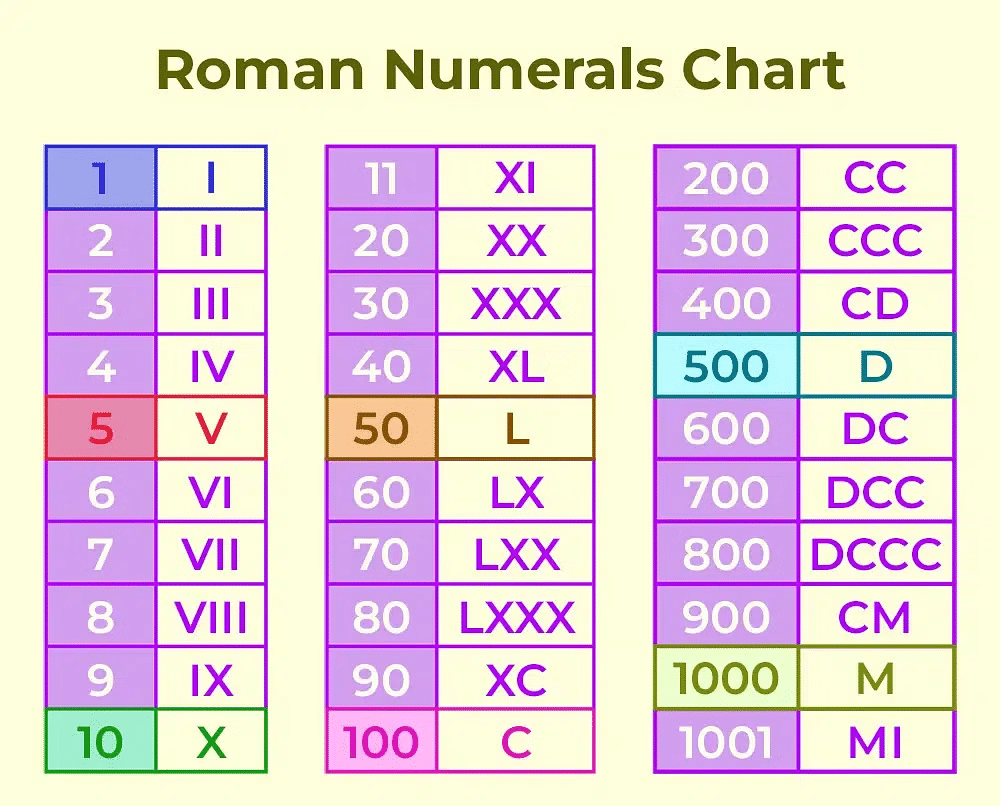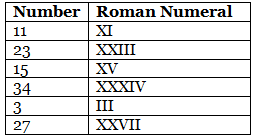Roman Numerals Class 4 Worksheet Maths
Q1: Write the Hindu-Arabic numerals for each of the following:
(a) XXXVIII
(b) XXIV
(c) XXIV
(d) CCLXXXII
(e) XLIII
Take help from this chart to understand:  Sol: To solve the given question, we will first find out in which form the numbers are given. Then, we will convert this form into numerical form by using the conversions given:
Sol: To solve the given question, we will first find out in which form the numbers are given. Then, we will convert this form into numerical form by using the conversions given:
I = 1, V = 5, X = 10, L = 50, C = 100 and D = 500.
After converting into numerical form, we will convert them into Hindu–Arabic numerals by placing commas at appropriate places.
(a) XXXVIII
Now, we know that X = 10 , V = 5 and I = 1. Thus, we will get,
XXXVIII = X + X + X + V + I + I + I
= 10 + 10 + 10 + 5 + 1 + 1 + 1
= 38
(b) XXIV
Now, we know that X = 10 , V = 5 and I = 1. As I is ahead of V, the value of IV will be
IV = (5-1) = 4
XXIV = X + X + I + V
= 10 + 10 + (5-1)
= 24
(c) DXIII
Now, we know that D = 500, X = 10 and III = 3. Thus, we will get,
DXIII = D + X + I + I + I
= 500 + 10 + 1 + 1 + 1 = 513
(d) CCLXXXII
Now, we know that C = 100, L = 50, X = 10 and I = 1. Thus, we get.
CCLXXXII = C +C + L + X +X + X +I + I
= 2(100) + 50 + 3(10) + 2(1) = 282
(e) XLIII
Now, we know that X = 10 and L = 50. As X is ahead of L, the value of XL will be
XL = (50 - 10) = 40
XLIII = 40 + 1 +1 + 1 = 43
Q2: Fill in the blanks using <, = or >:
(a) XXXIX ___ 39
(b) XVIII ___ 20
Sol:
(a) XXXIX = 39
First, let's convert the Roman numeral XXXIX to its equivalent in the Hindu-Arabic numeral system:
- X = 10
- XXX = 10 + 10 + 10 = 30
- IX = 9 (since I before X means 1 less than 10)
So, XXXIX = 30 + 9 = 39.
Now, we compare:
XXXIX = 39
Therefore, the correct answer is:
XXXIX = 39
(b) XVIII < 20
let's convert the Roman numeral XVIII to its equivalent in the Hindu-Arabic numeral system:
- X = 10
- V = 5
- III = 3
So, XVIII = 10 + 5 + 3 = 18.
Now, we compare:
18 is less than 20.
Therefore, the correct answer is:
XVIII < 20
Q3: At most, how many times can a symbol be repeated in Roman system?
Sol: A symbol is repeated three times but not more than that. However, the symbols V, L and D are never repeated. If a symbol of smaller value is written to the right of a symbol of greater value, its value gets added to the value of a greater symbol.
Q4: Which symbol in Roman system can never be subtracted?
Sol: The symbols V, L and D are not written to the left of a symbol that has greater value. This means that V, L and D are never subtracted.
Q5: Match the numerals of two columns which indicate the same number: Sol:
Sol:
Q6: Write each of the following in Roman numerals:
(a) 16
(b) 29
(c) 26
(d) 35
(e) 14
Sol: We will convert the Hindi-Arabic form into Roman Numerals form by using the conversions given: I = 1, V = 5, X = 10, L = 50, C = 100 and D = 500.
I = 1, V = 5, X = 10, L = 50, C = 100 and D = 500.
Hence,
(a) 16 in Roman numerals is XVI.
(b) 29 in Roman numerals is XXIX.
(c) 26 in Roman numeral is XXVI.
(d) 35 in Roman numerals is XXXV.
(e) 14 in Roman numerals is XIV.
Q7: Which of the following are meaningless
(a) XIX
(b) VX
(c) XVV
Sol: (b)
(a) XIX = The Roman numeral XIX is 19
(b) VX is meaningless according to the rules.
(c) XVV is meaningless according to the rules.
Q8: The Roman numeration system has no symbol for zero. Is this correct?
Sol: Yes, it is true, Roman numerals start to count from one and had no symbol to represent “0“. This happens because the Romans did not need to have a zero in their additive system.
Q9: Which is smaller 37 or XXXV?
Sol: XXXV is the smaller number.
In Roman numerals, XXXV = 3 x 10 + 5 = 35. ( X = 10 and V =5 )
Therefore, 37 > XXXV.
Q10: XX = 10 + 10 = 20. In the same way can we write W = 5 + 5 = 10?
Sol: No, it will be incorrect because there are roman numerals allotted for different numbers. Hence it is incorrect.
|
33 videos|168 docs|30 tests
|
FAQs on Roman Numerals Class 4 Worksheet Maths
| 1. What are the basic symbols used in Roman numerals? |  |
| 2. How are Roman numerals typically used in modern times? |  |
| 3. Can Roman numerals be combined to create larger numbers? |  |
| 4. How do you convert Roman numerals to Arabic numerals? |  |
| 5. Are there any limitations to using Roman numerals? |  |

















